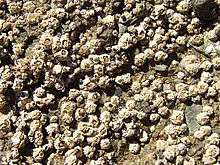Balanus glandula
| Balanus glandula | |
|---|---|
 | |
| Balanus glandula with Chthamalus fissus | |
| Scientific classification | |
| Kingdom: | Animalia |
| Phylum: | Arthropoda |
| Subphylum: | Crustacea |
| Class: | Maxillopoda |
| Infraclass: | Cirripedia |
| Order: | Sessilia |
| Family: | Balanidae |
| Genus: | Balanus |
| Species: | B. glandula |
| Binomial name | |
| Balanus glandula Darwin, 1854 | |
Acorn barnacles (Balanus glandula) are one of the most common barnacle species on the Pacific coast of North America, distributed from the U.S. state of Alaska to Bahía de San Quintín near San Quintín, Baja California.[1] They are commonly found in intertidal waters on mussels, rocks and pier pilings.[1]
The acorn barnacle is a moderate-sized barnacle with a diameter of up to 22 mm (0.9 in).[1] The shell is formed by overlapping plates and has a calcareous basis. It has more the shape of a cylinder than the shape of a cone. The white operculum has heavily ridged walls.[1] It can live up to ten years.[1]
It has been intensely studied in recent years as a model species for linking physical oceanography and population genetics (or phylogeography) surveys.[2] This species was introduced to the shores of Argentina in the 1970s, and has become an invasive species, displacing other barnacles and mussels.[3]
References
- 1 2 3 4 5 Robert Hugh Morris, Donald Putnam Abbott & Eugene Clinton Haderlie (1980). "Balanus glandula". Intertidal Invertebrates of California. Stanford: Stanford University Press. pp. 520–521. ISBN 978-0-8047-1045-9.
- ↑ Erik Sotka; John Wares; Jack Barth; Rick Grosberg; Steve Palumbi (2004). "Strong genetic clines and geographical variation in gene flow in the rocky intertidal barnacle Balanus glandula". Molecular Ecology. 13 (8): 2143–2156.
- ↑ Evangelina Schwindt (2007). "The invasion of the acorn barnacle Balanus glandula in the south-western Atlantic 40 years later". Journal of the Marine Biological Association of the United Kingdom. 87 (5): 1219–1225. doi:10.1017/S0025315407056895.